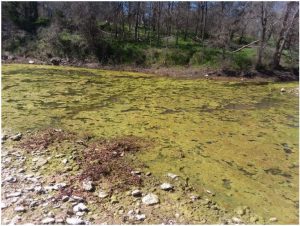
(Algae from treated sewage chokes Cibolo Creek)
The past decade has seen numerous developments sprouting up in the area around Bulverde,
Texas. Driven by close proximity to the one of the fastest-growing cities in the U.S., the
sprawling development in the Bulverde area is going largely unchecked, causing all sorts of
problems for local residents.
Winding through the Bulverde area is Cibolo Creek, a tributary of the San Antonio River. Cibolo
Creek is unique in that it contains numerous faults and fractures that recharge the Edwards
Aquifer. This connection between Cibolo Creek and the Edwards provides groundwater for
many who rely on wells for their household use and contributes to a healthy Edwards
ecosystem. Since developers are proposing very high density projects with as many as five or
six houses per acre, multiple sewage treatment plants seeking to discharge treated sewage
effluent into local creeks and streams have popped up to handle the waste of the burgeoning
Bulverde population.
While treated sewage has undergone removal of solids and bacteria, it is still high in nutrients
such as nitrogen and phosphorous, which are harmful to humans if ingested in high quantities.
Treated sewage, or effluent, also contains pharmaceuticals, hormones, microplastics, and other
harmful chemicals which can’t be easily removed during the sewage treatment process.
By Texas law, it is illegal to discharge treated sewage directly into waterways over the Edwards
Aquifer Recharge Zone. But developers have exploited a loophole in the law, discharging
instead into dry ditches and small tributaries that flow into Cibolo Creek and hence, into the
Edwards Aquifer. In essence, directly discharging sewage effluent into these small streams and
creeks which flow through the properties of others and may have a negative impact on the
water they draw from their wells is akin to you dumping your trash in your neighbor’s yard.
